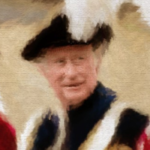The Head of the House of Aberffraw would be the de jure Prince of Gwynedd, and as they were the last native Princes of Wales – recognised in Wales, by the French crowns and the Pope- would be contenders to be the legitimate true Prince of Wales. Owain Glyndŵr descendants and those of the other Welsh Royal Houses might object and say they have a right to regarded as the true native Prince of Wales though.
So who is the rightful heir to the Kingdom of Gwynedd and the titles that follow?
Well, it depends. Welsh titles didn’t always descend via male primogeniture. That’s the eldest son of the eldest son of the eldest son. That was more a Norman or French thing. And that means that there might be more than one obvious heir to a Welsh title. It is also worth pointing out that in Wales illegitimacy was not a block to inheriting titles.
The Celtic way was more gavelkind. Most commonly the land got split between all the sons and any one of them has a claim to the title, so usually the previous King would appoint his heir while he was still alive. However this didn’t stop other sons, brothers or uncles from contesting their claim after he died.
The Irish often had an elected derbhfine with all the male line descendants of the previous leader’s great-grandfather.
What we now call the Scottish introduced the possibility of decent via female lines; most famously with the Pict Kings in certain circumstances, and it has evolved to where females can be chief of a clan (as long as they keep/take the clan surname) or hold a British Peerage title.
Titles in the Roman Empire also passed through the female line via the adoption by the male ruler of a child of a female relative. The most famous example is the future Caesar Augustus, Octavian, being formally adopted by his maternal great-uncle Julius Caesar to continue
This concerns the House of Aberffraw as the Kingdom of Gwynedd was deeply influenced both by Roman and “Scottish” practices.
Other Welsh Royal Houses allowed decent only through the male line. This is seen through de facto practice and historians tend to point to “Welsh Law”, aka the Law of Hywel Dda ,to back this up. In actual fact the laws explicitly allows grandsons of an Irish, Scottish or English father to inherit from their maternal grandfather as if they were their mother’s brothers under “the law of mamwys”. They are literally regarded as “sons” of their maternal grandfather. The only exception is that only a the grandchildren whose father was a “chieftain” or the “son of a chief” can inherit the principle estate.
Irish & Scottish chiefs still exist. The best explanation to what was meant would be the Continental European idea of “untitled nobility” at the low end and Kings or Dukes at the high. Traditionally, as Affirmed by James II when he was exiled, those with a documented right to an English or Scottish coat of arms would be expected to be treated as untitled nobility by the European courts and nations.
It’s apparent that the House of Aberffraw also allowed the a previous ruling male line to revert the House back, if it had previously alternated to a female line through the law of mamwys as Rhodri the Great did.
Several of these potential heirs do trace decent through female lines. However, as long as it is not a “double-female” line of father-daughter-daughter-son, and the maternal grandson’s father either was a foreign armiger, or of the male line of Cunedda or Ceneu or Gorbanian sons of Coel Hen’s wife Stradweul or Rhodri Mawr then under the laws of Hywel Dda they remain part of the House of Aberffraw.
Lastly we have to be realistic that in today’s day and age, the idea that grandsons should inherit nothing from their maternal grandparents or that daughters should be cut out is anachronistic in the extreme and even the British crown has backed away from this. Plus, when an invader attempts to slaughter your entire dynasty “all bets are off”, which is why Owain Glyndŵr stressed his decent from the House of Aberffraw via the female line, widely attributed to an unknown daughter of Llywelyn the Last, but thought by Welsh genealogy experts to actually be the daughter of his grandfather Llywelyn the Great.
So who should, or could, inherit as head of the House of Aberffraw?
Should it be “strict” male line only inheritance, under the “old laws” even though the Kingdom of Gwynedd passed in the female line at least 3 times?
And then a claim passing to every male descendent equally or by primogeniture only?
If an English court judges that you are the de jure Prince of Gwynedd on the basis “male only primogeniture”; does that judgement pass through the female line when your male line dies out and you leave a female heir in the 1700s or go back to the next most senior male line heir?
Does the law of mamwys come into play?
Should it be “Possession is 9/10ths of the law” and stick with Prince Charles as he is recognised worldwide as “Prince of Wales”? He is a descendant of Llywelyn the Great. Does it make sense that he, a descendent of the grandfather of the last two princes of Gwynedd, has less of a claim than a male line descendent of Llywelyn the Great’s grandfather Owain Gwynedd,?
As one person has said, “Wales is an occupied sovereign Indigenous land stolen by the British crown and the English version of the title ‘Prince of Wales’ was created in 1301 for the soul purpose of reminding the Welsh they were conquered. It’s continued use is a purposeful insult.”
So should he be disqualified because he is using the English “Prince of Wales” title, rather than honouring the native Welsh “Prince of Wales” title?
Or the growing academic claims that Henry Tudor forged his pedigree to tack himself onto rulers of the Kingdom of Gwynedd for propaganda reasons? Does decent through a female-female line invalidating the law of mamwys?
Do we take the alleged pedigree of Llywelyn the Last’s descendants via an unkown daughter seriously? Most Welsh genealogical experts believe them actually to be the decent from a daughter of his grandfather Llywelyn the Great. Some of the would be “heirs” do have this line in their pedigrees. Does this further diminish Prince Charles’ claim as so many alternative heads of the House of Aberffraw also have this decent?
Should the heir already be someone with a title?
Or someone who can use the title “Prince of Gwynedd” with a straight face and not be ridiculed, as Joe “Bach” Blogs or even a Baronet may be?
Scottish Earls, whose Earldoms were created before the Act of the Union, have been styled “The Most Noble and Puissant Prince the Earl of…” by the Lyon Court. Does that style possibly extend to (British granted) Irish Earls? If not we’re stuck with the British Royal Family or Irish clan chiefs as the only two groups of people in the British Isles of whom it is deemed socially acceptable to use “prince of…” styles.
Do all (or some) potential heirs hold a right to the titles in their plural form; rather than there being one rightful ‘THE Prince of Gwynedd’, could there be several heirs who could plausibly claim to be ‘A Prince of Gwynedd’, in the same way that all legitimate male line descendent of certain Counts of the Holy Roman Empire all hold the same “Count of X” title?
Prince of Gwynedd, Prince and Lord of Aberffraw, Lord of Ynys Môn and Eryri were all certainly used by Cynan ab Iago after he was whisked to Ireland as a baby when his father the King was overthrown. His son, the Dublin born, half-Irish Gruffudd ap Cynan used those titles, as well as Prince of Wales, decades before ever gaining back the throne of Gwynedd. Five of his grandsons, through his son Owain Gwynedd and Owain’s Irish wife, lived on estates in Ireland and all seem to have used the “Prince of Aberffraw” title. Even generations after are named with corruptions of “Prince/Lord of Malltraeth” (aka Aberffraw), “of Wales”, “Son of the King”
If several of the potential heirs to the throne of Gwynedd can all use titles as “a” rather than “the” Prince or Lord then which ones are allowed and which are not?
Should it be a descendent of the last Prince of Gwynedd, Dafydd ap Gruffydd no matter how many female lines it goes through?
Or in the male line from Cunedda, now that we know his descendent were never extinguished in the male line?
Or a male line descendent of the female heir of Eduaf Hen, his claim passing through the brother rather than his sister, Cunedda’s mother?
Does a potential head of the House of Aberffraw have to be born in Wales? Their heirs born in Wales too? Or grew up here? Have a Welsh accent? Identify with the House of Aberffraw?
Evan Anwyl of Tywyn

The senior male line descendant of Owain Gwynedd, whose undifferentiated coat of arms the College of Arms has confirmed he is allowed to use as his own.
His Mancunian son and heir only has daughters so the strict male line will go to his childless Irish cousin, then to another childless English cousin. Neither are expected to ever have children of their own.
When asked if he wanted to become Prince of Wales he has replied “We’ve always been proud of our family tree, but only amongst ourselves. Beyond that, no”, and if his son were interested in his heritage: “Even less than me. Mind you, if it had been anything to do with cricket.…”
Sir David Watkin Williams-Wynn, 11th Baronet

Descended from the male line of Owain Gwynedd with just one female line break.
The Wynn’s of Gwydir were the previous senior male line descendants of Owain Gwynedd before dying out in the female line. When Sir John Wynn died in 1719 his estates went to his daughter Jane Thelwall and her husband Watkin Williams added the Wynn name to his own to become Williams-Wynn.
A previous Sir John Wynn got an English court to rule that he was de jure Prince of Gwynedd, based on male only primogenture.
His heir is his son who went to the same school as Prince Charles.
The Williams-Wynn Baronets claim that the Sir John Wynn’s claim to be de jure Prince of Gwynedd passed from Sir John Wynn through Jane Thekwall to the Williams-Wynn Baronets and have authorised the press to refer to them in terms such as “the closest certain heir of the House of Aberffraw”.
Laurence Michael de Sybylltir

Descended from the male line of Owain Gwynedd with two female line breaks.
A half-French family originally from Sybylltir in Wales, who adopted the French for “of Sybylltir” as their surname, and the undifferentiated coat of arms of Owain Gwynedd.
In the 1700s the one of the Michaels of Holyhead married the daughter of a man whose maternal grandmother descended in the male line from Owain Gwynedd.
Laurence de Sybylltir was at the 2010 Elystan Glodrydd celebrations “representing Gwynedd” alongside Lord Powis (for Powys), Lord Windsor (for Morgannwg/Senghenydd) and Lord Dynevor (for Deheubarth). He is the only one of the descendants of the House of Aberffraw to publicly represent the Princes of Gwynedd.
Sir William Basil John Mostyn, 15th Baronet

A male line descendant of Hwyl Dda King of Deheubarth, son of Cadell King of Seisyllwg, son of Rhodri The Great, Prince of Gwynedd of the the Merfynion.
They are the Mostyn baronets, of Talacre, now based in London & his wife’s South Asian homeland.
His heir is his minor son, who is expected to be the senior male line heir of the Merfynion, the Second Dynasty of Gwynedd, when the male line of the Anwyls of Tywyn expires.
Lord Gregory Philip Roger Lloyd-Mostyn, 7th Baron Mostyn, 8th Baronet

Male line descendant of Hwyl Dda with one female break.
Splits his time between between the estate he inherited in Wales and his home in Chelsea where he was born and raised. Fluent in Japanese and somewhat of a celebrity there, Lord Mostyn still goes to Tokyo, Hiroshima and Kyoto once a year to relax.
The heir presumptive is Lord Mostyn’s third cousin twice removed, a medical Dr from England.
He has said: “I can also speak for the underrepresented northwest of England and Wales as I am located in north Wales. I have years of experience in local business as I run an estate that covers much of Wales”
Sir Richard Thomas Williams-Bulkeley, 14th Baronet

A male line descendant of Ceneu son of Coel Hen Godebog and his wife Ystrawel the female heir of Eduaf Hen. Ceneu was the brother of Cunedda’s mother Gwawl and so male line descendant of the female heirs of Eduaf Hen, King in Aberffraw.
Of the Williams, later Williams-Bulkeley baronets, of Penrhyn.
An old Etonian, Sir Richard served in the Welsh guards. His heir is his son, an auction specialist at the world famous Christie’s.
Lord David John Francis Malet Vaughan, 9th Earl of Lisburne (Irish)

Male line descendant of Cunedda, founder of the “First Dynasty of Gwynedd”, the Maelgyning.
Lord David’s son and heir was born out of wedlock which means that the Earldom will pass to his brother. Illegitimacy was no bare for succession in Gwynedd however.
Scottish Earldoms which were pre-Union were dubbed “Prince” but don’t appear to use that terminology any more. There is no evidence that Irish Earls did, and the Earldom of Lisburne was granted 69 years after the Act of the Union, however the holder of a celtic Earldom calling himself “Prince of Gwynedd” or “Prince of Aberffraw” might be more acceptable than a baronet or commoner doing so.
Críostóir ap Ieuan, Chief of Clan MacSiúbhlaigh (Irish)

Descendent of the last prince of Aberffraw, Dafydd ap Gruffydd via several female line breaks via male lines of Cunedda, Ceneu and the law of mamwys.
Born England, baptised Westminster Abbey, brought up in Wales. His heir is his minor son.
Irish clan chiefs and possibly Scottish pre-Union Earls are the only people in Britain and Ireland outside the British Royal family to currently use the style “prince of”.
Charles Philip Arthur George Mountbatten-Windsor

Descendant of Llywelyn the Great, the last but three native reigning Prince of Wales, Prince of Gwynedd via two lines. Both are via seven female line breaks including one “double break”- a mother, daughter decent pair.
Claimed decent from Llywelyn the Last’s “daughter” Catherine and her husband Philip ap Ivor’s daughter Elanor, and her daughter Margaret is believed by modern academics to either to actually be another daughter of Llywelyn the Great or a Tudor invention to give Henry Tudor added legitimacy and support from Welsh troops.
The longest “English” Prince of Wales, uses the Coat of Arms of Llywelyn the Last with the crown of Edward placed on top of it as “arms of conquest” on top of his own royal coat of arms. His heir is his son William, Duke of Cambridge.
You

Realistically if you are Welsh for more than two or three generations, or have the blood of a Welshman or Welsh woman who was, flowing through your veins, then you are likely a descendant of the House of Aberffraw.
The difference between you and I, and all those “heirs to the Princedom of Gwynedd”? They can prove it, and their lines of decent are a little more “showy”; decent from a particular Prince, or via a certain male line.
However…
We are all Royal, for we are Cymry!